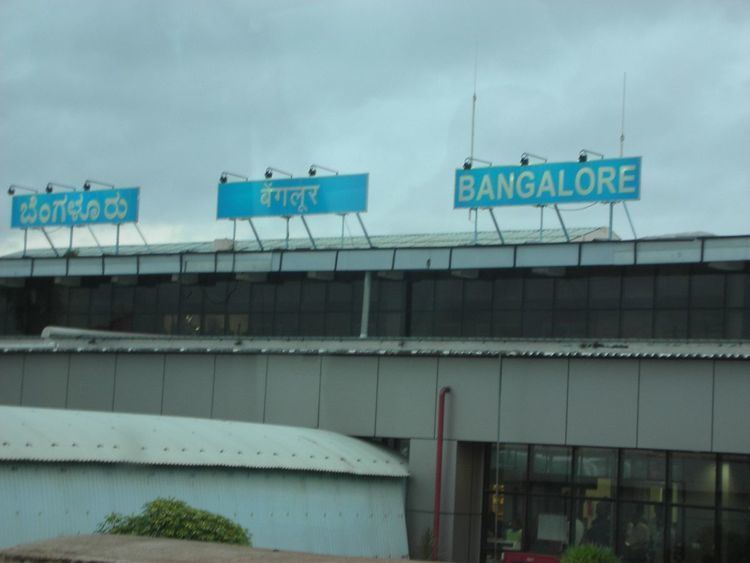Airport type Military 09/27 10,850 Elevation 888 m | Elevation AMSL 2,912 ft / 888 m 10,850 3,307 Phone 080667 84444 | |
 | ||
Operator Hindustan Aeronautics Limited
Airports Authority of India Location Bangalore, Karnataka, India Address Devanahalli, Bengaluru, Karnataka 560300 Similar MakeMyT, Bengaluru City Junction, Bengaluru Mega Cabs Pvt Ltd, Air India, Jet Airways India | ||
Photo real hal bangalore airport for microsoft flight simulator 2004
HAL Bangalore Airport (ICAO: VOBG), also known as HAL Airport or Hindustan Airport, is an airport located in Bangalore, Karnataka, India. Due to its location in the heart of the city, it is the preferred destination for general and business aviation. The airport is also used as a testing facility by Hindustan Aeronautics Limited and the Indian Armed Forces. It served as the city's domestic and international airport until 24 May 2008, when it was replaced by the new Kempegowda International Airport in Devanahalli. There have since been repeated attempts to restart commercial service at the airport.
Contents
- Photo real hal bangalore airport for microsoft flight simulator 2004
- History
- Transfer of civilian operations
- Facilities
- Closed structures
- Incidents and accidents
- References
History
The airport was constructed in 1940 by Walchand Hirachand, founder of Hindustan Aircraft Company (now Hindustan Aeronautics Limited), as an aircraft manufacturing centre. Two years later, the airport was requisitioned by the British for use by the Royal Air Force in order to protect India from Japan during World War II.
In 1964 the airport was acquired by newly established Hindustan Aeronautics Limited. Commercial flights, initially only domestic, began in 1980.
The first international flights from HAL Airport began in 1997. In September 2001, Lufthansa commenced flights between Frankfurt and Bangalore, marking the airport's first nonstop link to Europe. British Airways and Air France followed in October 2005 with flights to London and Paris, respectively. In the same month, Northwest Airlines was to begin the first direct service between Bangalore and the United States, from Seattle via Amsterdam. However, due to the airline's poor financial condition at the time and rising fuel costs, Northwest canceled its plans.
Transfer of civilian operations
During the 2000s, commercial traffic to HAL Airport was rising at a rate of roughly 35% per year. Between 2006 and 2007 the airport received 8.2 million passengers, well above its capacity of 3.6 million.
Because of this, in July 2004 the Government of India permitted the construction of another airport for Bangalore after a Concession Agreement with Bangalore International Airport Limited (BIAL, the company that operates the Airport), situated 30 km (19 mi) from the city in Devanahalli. The new airport, named Kempegowda International Airport, Bengaluru (KIAB), opened on 24 May 2008. Per the Government's decision that no two commercial airports could exist within a 150 km (93 mi) radius, all passenger flights were transferred from HAL Airport to KIAB.
Since then, there have been several attempts to reinstate commercial air service at HAL Airport. Shortly before BIAL's opening, 20,000 employees of the Airports Authority of India went on strike against the closure of HAL Airport and Begumpet Airport in Hyderabad. In January 2015, Defence Minister Manohar Parrikar appealed to the Civil Aviation Minister to reopen HAL Airport, citing its loss of revenue and its convenient location within Bangalore. However, the Indian Government has repeatedly denied these requests in accordance with its 150 km policy.
Facilities
HAL Airport has one runway, 09/27, with a length of 3,307 metres (10,850 ft). There are 4 entry/exit taxiways, 2 on the east side named E2 (perimeter) and E1. Similarly there are 2 taxiways on the west side - W2 (perimeter) and W1. In addition, there are six aprons.
Closed structures
The passenger terminal was located on the north side of the airport. It contained two jetways and separate sections for domestic and international flights. Despite the rise in passenger traffic, there was no room to expand the terminal, and the apron in front of it could only park six aircraft.
